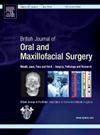Comparison of melatonin and music therapy as a preoperative anxiolytic for patients undergoing impacted mandibular third molar extraction: a double-blind randomised controlled trial
IF 1.9
4区 医学
Q3 DENTISTRY, ORAL SURGERY & MEDICINE
British Journal of Oral & Maxillofacial Surgery
Pub Date : 2025-06-01
DOI:10.1016/j.bjoms.2025.03.009
引用次数: 0
Abstract
Dental preoperative anxiety poses significant challenges in healthcare, leading to treatment avoidance and prolonged recovery times. Despite the plethora of pharmacological and psychotherapeutic interventions employed for anxiety management, their relative efficacy remains unclear. This study aims to compare the effectiveness of oral melatonin (6 mg) and music therapy in preoperative anxiety management among patients undergoing surgical extraction of impacted mandibular third molars. A total of 78 patients aged 18–40 years undergoing surgical extraction were selected and randomly assigned into three groups: nil intervention (Group NI) with no intervention, Group ML administered oral melatonin, and Group MT administered 20 min of relaxing music (n = 26). Physiological parameters (pulse rate, blood pressure) and subjective assessments (visual analogue scale for anxiety) were measured on arrival (T1), after the intervention (T2), and after surgical extraction (T3). Salivary cortisol levels, recorded preoperatively and postoperatively, were analysed using ELISA. Results showed significant improvement in physiological parameters for both ML and MT compared with NI (p < 0.05). However, postoperative cortisol levels increased significantly in the NI (0.55 (0.15) - 0.88 (0.32) pmol/ml) and MT groups (from 0.33 (0.15) - 0.62 (0.2) pmol/ml) but decreased in the ML group (from 0.42 (0.19) - 0.3 (0.14) pmol/ml). This indicated a delayed action of melatonin as compared with the immediate impact of music therapy. Understanding the mechanisms and insights obtained can aid in developing advanced anxiety management methods for dental practitioners, thereby enhancing patient care and outcomes in dental practice.
褪黑素和音乐治疗作为下颌阻生第三磨牙拔牙患者术前抗焦虑药的比较:一项双盲随机对照试验。
牙科术前焦虑对医疗保健构成重大挑战,导致治疗逃避和恢复时间延长。尽管有大量的药理学和心理治疗干预用于焦虑管理,但它们的相对功效仍不清楚。本研究旨在比较口服褪黑素(6mg)和音乐治疗对下颌阻生第三磨牙手术拔牙患者术前焦虑管理的效果。选择78例年龄在18-40岁的手术拔牙患者,随机分为三组:无干预组(NI组),不干预,ML组给予口服褪黑激素,MT组给予20分钟的放松音乐(n = 26)。生理参数(脉搏率、血压)和主观评估(焦虑视觉模拟量表)分别在到达时(T1)、干预后(T2)和手术取出后(T3)进行测量。采用ELISA法分析术前、术后唾液皮质醇水平。结果显示,与NI相比,ML和MT的生理参数均有显著改善(p
本文章由计算机程序翻译,如有差异,请以英文原文为准。
求助全文
约1分钟内获得全文
求助全文
来源期刊
CiteScore
3.60
自引率
16.70%
发文量
256
审稿时长
6 months
期刊介绍:
Journal of the British Association of Oral and Maxillofacial Surgeons:
• Leading articles on all aspects of surgery in the oro-facial and head and neck region
• One of the largest circulations of any international journal in this field
• Dedicated to enhancing surgical expertise.

 求助内容:
求助内容: 应助结果提醒方式:
应助结果提醒方式:


